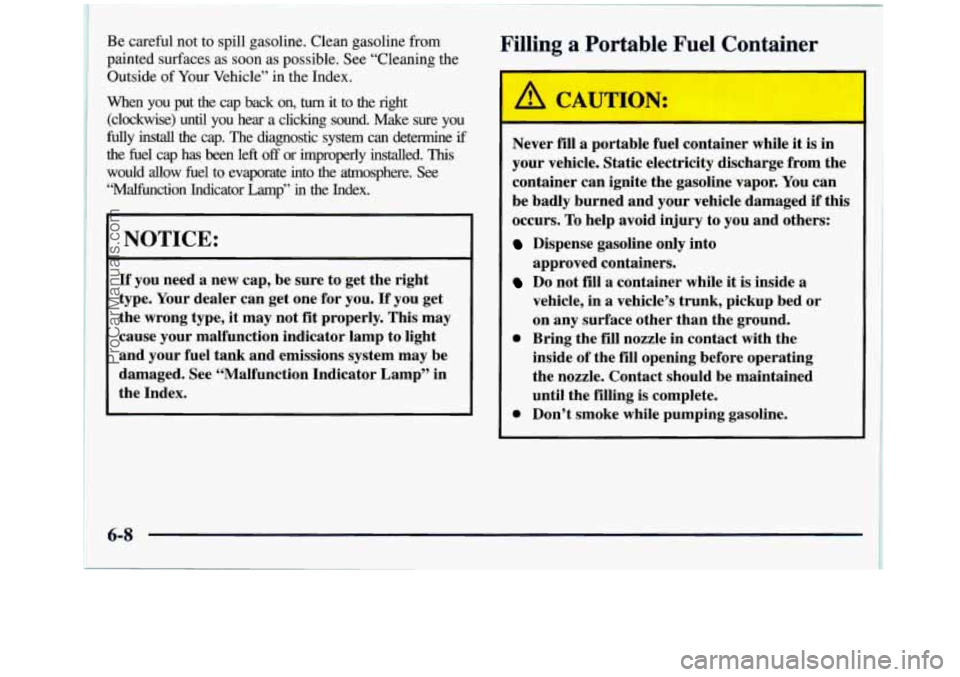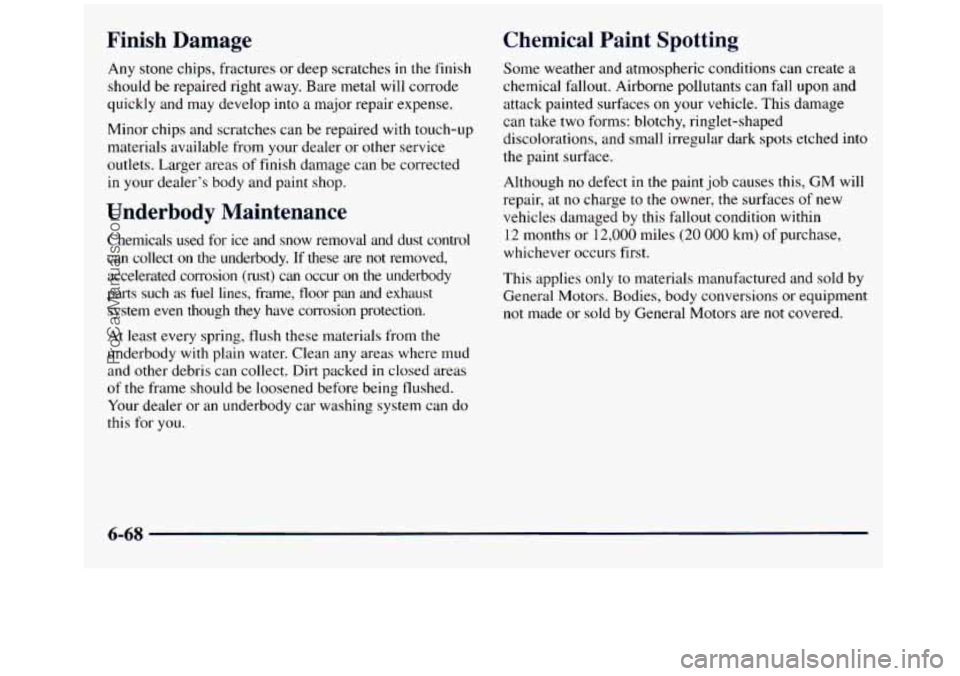Page 297 of 452
While refueling, let the cap hang by the tether below the
fuel filler neck.
To remove the cap, turn it slowly to the left
(counterclockwise).
If you get gasoline on yourself and then
something ignites it, you could be badly burnea.
Gasoline can spray out on you if you open the
fuel filler cap
too quickly. This spray can happen
if your tank is nearly full, and is more likely in
hot weather. Open the fuel filler cap slowly and
wait for any “hiss” noise to stop. Then unscrew
the cap
all the way.
6-7
ProCarManuals.com
Page 298 of 452

~ Be
careful not to spill gasoline. Clean gasoline from
~ painted surfaces as soon as possible. See “Cleaning the
i Outside of Your Vehicle” in the Index.
When you put
the cap back on, turn it to the right
(clockwise)
until you hear a clicking sound. Make sure you
fully install the cap. The diagnostic system can determine if
the fuel cap has been left off or improperly installed. This
would allow fuel to evaporate into the atmosphere. See
“Malfunction Indicator Lamp”
in the Index.
NOTICE:
If you need a new cap, be sure to get the right
type. Your dealer can get one for you. If you get
the wrong type, it may not
fit properly. This may
cause your malfunction indicator lamp to light
and your fuel tank and emissions system may be
damaged. See ‘LMalfunction Indicator Lamp” in
the Index.
Filling a Portable Fuel Container
Never fill a portable fuel container while it is in
your vehicle. Static electricity discharge from the
container can ignite the gasoline vapor. You can
be badly burned and your vehicle damaged
if this
occurs.
To help avoid injury to you and others:
Dispense gasoline only into
approved containers.
Do not fill a container while it is inside a
vehicle, in
a vehicle’s trunk, pickup bed or
on any surface other than the ground.
inside of the
fill opening before operating
the nozzle. Contact should be maintained
until the filling is complete.
0 Bring the fill nozzle in contact with the
0 Don’t smoke while pumping gasoline.
6-8
I
ProCarManuals.com
Page 299 of 452
Checking Things Under the Hood
I I A CAUTION:
If your vehicle has air conditioning, the auxiliary
engine fan under the hood can start up and
injure you even when the engine is not running.
Keep hands, clothing and tools away from any
underhood electric fan.
I
A CAUTION:
I
I
Things that burn can get on hot engine parts and
start a fire. These include liquids like gasoline or
diesel fuel, oil, coolant, brake fluid, windshield
washer and other fluids, and plastic or rubber.
You or others could be burned. Be careful not
to drop or spill things that
will burn onto a
hot engine.
6-9
ProCarManuals.com
Page 304 of 452
Engine Oil (Gasoline Engine)
If your vehicle has a diesel engine, see “Engine Oil
(Diesel Engine)” in the Diesel Engine Supplement.
It’s
a good idea to check your engine oil every time you
get fuel. In order to get an accurate reading, the
oil must
be warm and the vehicle
must be on level ground.
.. ..
The engine oil dipstick has a yellow ring handle and is
located
on the passenger’s side of the engine.
Turn
off the engine and give the oil a few minutes to
drain back into
the oil pan. If you don’t, the oil dipstick
might not show the actual
level.
Checking Engine Oil
Pull out the dipstick and clean it with a paper towel or
cloth, then push it back in all the way. Remove it again,
keeping the tip down, and check the level.
u
6-14
ProCarManuals.com
Page 306 of 452
What Kind of Engine Oil to Use
Oils recommended for your vehicle can be identified by
looking for the “Starburst” symbol. This symbol
indicates that
the oil has been certified by the American
Petroleum Institute (API).
Do not use any oil which
does not carry this Starburst symbol.
If
you change your own oil,
be sure you use oil that has
the Starburst symbol on the
front of the oil container.
If you have your oil changed for you, be sure the oil put
into your engine
is American Petroleutn Institute
certified for gasoline engines.
You should
also use the proper viscosity oil for your
vehicle, as shown in the following chart:
RECOMMENDED SAE VISCOSITY GRADE ENGINE OILS
FOR BEST FUEL ECONOMY AND COLD STARTING, SELECT THE LOWEST
SAL VISCOSITY GRADE OIL
FOR THE EXPECTED TEMPERATURE RANGE.
LOOK
FOR THIS
SYMBOL
COLD
WEATHER
DO NOT USE SAE 2OW-50 OR ANY OTHER GRADE OIL NOT RECOMMENDED
6-16
ProCarManuals.com
Page 342 of 452
Inflation -- Tire Pressure
The CertificationlTire label, which is on the rear edge of
the driver’s door, or on the incomplete vehicle document
in the cab, shows the correct inflation pressures for your
tires when they’re cold.
“Cold” means your vehicle has
been sitting for at least three hours or driven no more
than
1 mile (1.6 krn).
NOTICE:
Don’t let anyone tell you that underinflation or
overinflation is all right.
It’s not. If your tires
don’t have enough
air (underinflation), you can
get the following:
0 Too much flexing
Too much heat
0 Tire overloading
0 Bad wear
Bad handling
0 Bad fuel economy.
If your tires have too much air (overinflation),
you can get the following:
0 Unusual wear
0 Bad handling
0 Rough ride
0 Needless damage from road hazards.
6-52
ProCarManuals.com
Page 358 of 452

Finish Damage Chemical Paint Spotting
Any
stone chips, fractures or deep scratches in the finish
should be repaired right away. Bare metal will corrode
quickly and may develop into a major repair expense.
Minor chips and scratches can be repaired with touch-up
materials available from your dealer or other service
outlets. Larger areas of finish damage can be corrected
in your dealer’s body and paint shop.
Underbody Maintenance
Chemicals used for ice and snow removal and dust control
can collect
on the underbody. If these are not removed,
accelerated corrosion (rust) can occur on the underbody
parts such as fuel lines, ft-ame, floor pan and exhaust
system even though they have colrosion protection.
At least every spring, flush these materials from the
underbody with plain wate.r. Clean any areas where mud
and other debris can collect. Dirt packed in closed areas
of the frame should be loosened before being flushed.
Your dealer or an underbody car washing system can do
this
for you.
Some weather and atmospheric conditions can create a
chemical fallout. Airborne pollutants can fall upon and
attack painted surfaces
on your vehicle. This damage
can take two forms: blotchy, ringlet-shaped discolorations, and small irregular dark spots etched into
the paint surface.
Although
no defect in the paint job causes this, GM will
repair, at no charge to
the owner, the surfaces of new
vehicles damaged by this fallout condition within
12 months or 12,000 miles (20 000 km) of purchase,
whichever occurs first.
This applies only to materials manufactured and sold by
General Motors. Bodies, body conversions or equipment
not made or sold by General Motors are not covered.
6-68
ProCarManuals.com
Page 365 of 452
STARTER RELAY
[-I
[-I
[T)
I BLOWER
n STOPiHAZ
Name
ECM-B RR DEFOG
IGN-E
FUEL
SOL
GLOW PLUG
Usage
Horn, Underhood Lamps
Auxiliary Fan
Injectors, PCM/VCM
Not Used
Air Conditioning
Not Used
Ignition Switch, EGR, Canister
Purge, EVRV Idle Coast Solenoid,
Heated
02, Fuel Heater
(Diesel Engine), Water Sensor
(Diesel Engine)
HTD ST-RR Not Used
LIGHTING Headlamp and Panel Dimmer
BATT Battery, Fuse Block Busbar
IGN-A Ignition Switch
IGN-B Ignition Switch Switch,
Fog and Courtesy Fuses
ABS Anti-Lock Brake Module
BLOWER High Blower Relay
STOP/HAZ Stoplamps
HEATED SEATS Not Used
6-75
Usage
Fuel Pump, PCM/VCM
Rear Window Defogger
Auxiliary Fan Relay Coi
il, AIC
Compressor Relay, Hot Fuel
Module, Dual Tanks
Fuel Solenoid (Diesel Engine)
Glow Plugs (Diesel Engine)
Name
HORN
AUX FAN
ECM- 1
HTD ST-FR
AIC HTD MIR
ENG-
1
ProCarManuals.com